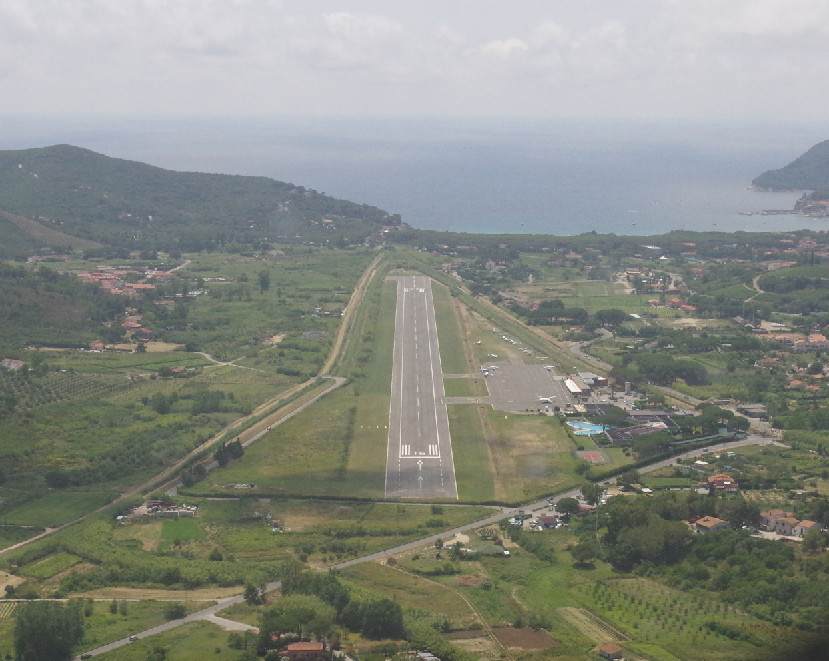I prefer to fly steep descents but it does scare passengers sometimes…
This one is to Elba, and there wasn’t much choice, but I happily do the same into Shoreham…

I always make a steep approach after a visual traffic circuit to keep the circuit short while still turning final at a reasonable height. At my home airfield (630 m grass) 5-6° approaches are standard practise.
My straight-in finals are shallover – if there is a PAPI, I will follow it.
Yes, like this space shuttle one-
Like all approaches I like to keep them pretty standard. I am not totally in favour of the lets keep it at 1000’, 1 mile final, routine. Unless I am in a YAK52… 
To expand on the OP question. Do I fly them, no, not often unless the approach path, and airfield topography demands it. i.e trees on the approach, tall poles, wires etc. I view my flying with an A-B-C-, building block mentality. Once you come out of the rhythm, the systematic routine approach to it, things can start to go wrong, particularly in the early years of training and mint PPL. Few months back, there was a long forum debate, think on the one we do not name, on the merits of using a check-list. Several sky gods belittled the very notion of using a check-list. We had all the usual suspects. What, use a check-list on a BUGSMASHER, a SPAMCAN, good grief, if one cannot fly without a check-list, one should not be in the air – top hole and all that.
Needless to say, I removed myself from the debate, on the premise, that I evidently did not qualify as a SkyGod…….me and my check-lists…
I find again, that unusual, non standard, call them what you will, approaches, fall roughly in line with not using check-lists.
I’m happy to do a steep approach if needed, but I don’t do steep approaches by default.
Where I do find them very useful is on short field landings. The act of flaring to convert a forward speed to reducing the significant vertical speed takes away a lot of the forward speed in steep approach. So it allows me to have a reasonable buffer over the stall speed, during the approach, and to pretty much be right at the stall once I’ve flared. It’s a great way of getting down at the very start of the runway with minimum ground speed.
Of course you got to make sure there there is enough excess energy to complete the flare properly, otherwise it’s a bit embarrassing!
I happily do whichever approach is necessary. At short runways and no obstacles i prefer to come in rather flat … but if there’s obstacles I have no problem coming in steep. If necessary the SR22 slips quite well … and the 4-blade prop has such a big braking at idle power effect that it’s not a problem to come in steep. London’s City Airport has a 5.8 degree glide slope, right?
Peter, I have re run that video several times, and each time, I sit there wondering at what point did it cross this poor guys mind, that things may not be looking quite right.
I should not, but I laugh every time I see it, especially when he pats those prop tips, time, and time, and time again. Thankfully, other than a huge amount of pride, no one hurt..
Where I do find them very useful is on short field landings. The act of flaring to convert a forward speed to reducing the significant vertical speed takes away a lot of the forward speed in steep approach. So it allows me to have a reasonable buffer over the stall speed, during the approach, and to pretty much be right at the stall once I’ve flared. It’s a great way of getting down at the very start of the runway.
I do that now too, when flying a plane with flaps and constant speed prop. I found (much to my surprise) that an extra 5 kts on final has little effect with a steeper approach, with that kind of plane. The steeper approach can be very useful, and also better if the engine quits – because the plane glides like a brick power off in that high drag configuration.
It was competely different when learning to fly on a plane with no flaps, very little drag from the fixed pitch propeller, low wing loading and tailwheel landing gear. That plane needed to be held right on speed, a bit slow by feel, and maybe slipped to maintain glide path. More like balancing on the head of a pin. If you did it just right you could three point at the spot you chose and land short. If you were a bit steep or fast, you’d float forever.
In answer to the OP, I fly whatever approach is right for the plane and circumstances. Figuring out what that might be and doing it is a big part of the fun of flying.
I do not understand why some pilots do not do a FINAL CHECK … Landing Light, Full Flaps, Gear Down … It’s so easy to do and it saves so much money. … I can also not understand how they can not hear that warning!